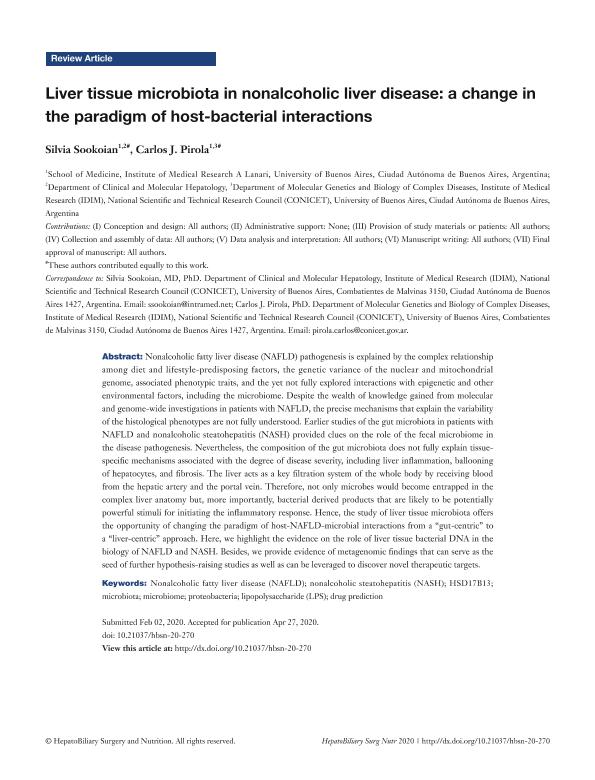Artículo
Liver tissue microbiota in nonalcoholic liver disease: a change in the paradigm of host-bacterial interactions
Fecha de publicación:
08/2020
Editorial:
AME Publishing Company
Revista:
Hepatobiliary Surgery and Nutrition
ISSN:
2304-3881
e-ISSN:
2304-389X
Idioma:
Inglés
Tipo de recurso:
Artículo publicado
Clasificación temática:
Resumen
Nonalcoholic fatty liver disease (NAFLD) pathogenesis is explained by the complex relationship among diet and lifestyle-predisposing factors, the genetic variance of the nuclear and mitochondrial genome, associated phenotypic traits, and the yet not fully explored interactions with epigenetic and other environmental factors, including the microbiome. Despite the wealth of knowledge gained from molecular and genome-wide investigations in patients with NAFLD, the precise mechanisms that explain the variabilityof the histological phenotypes are not fully understood. Earlier studies of the gut microbiota in patients with NAFLD and nonalcoholic steatohepatitis (NASH) provided clues on the role of the fecal microbiome in the disease pathogenesis. Nevertheless, the composition of the gut microbiota does not fully explain tissuespecific mechanisms associated with the degree of disease severity, including liver inflammation, ballooning of hepatocytes, and fibrosis. The liver acts as a key filtration system of the whole body by receiving bloodfrom the hepatic artery and the portal vein. Therefore, not only microbes would become entrapped in the complex liver anatomy but, more importantly, bacterial derived products that are likely to be potentially powerful stimuli for initiating the inflammatory response. Hence, the study of liver tissue microbiota offers the opportunity of changing the paradigm of host-NAFLD-microbial interactions from a ?gut-centric? to a ?liver-centric? approach. Here, we highlight the evidence on the role of liver tissue bacterial DNA in the biology of NAFLD and NASH. Besides, we provide evidence of metagenomic findings that can serve as the seed of further hypothesis-raising studies as well as can be leveraged to discover novel therapeutic targets.
Palabras clave:
NAFLD
,
NASH
,
MICROBIOTA
,
TISSUE MICROBIOTA
Archivos asociados
Licencia
Identificadores
Colecciones
Articulos(IDIM)
Articulos de INST.DE INVEST.MEDICAS
Articulos de INST.DE INVEST.MEDICAS
Citación
Sookoian, Silvia Cristina; Pirola, Carlos José; Liver tissue microbiota in nonalcoholic liver disease: a change in the paradigm of host-bacterial interactions; AME Publishing Company; Hepatobiliary Surgery and Nutrition; 8-2020; 1-13
Compartir




